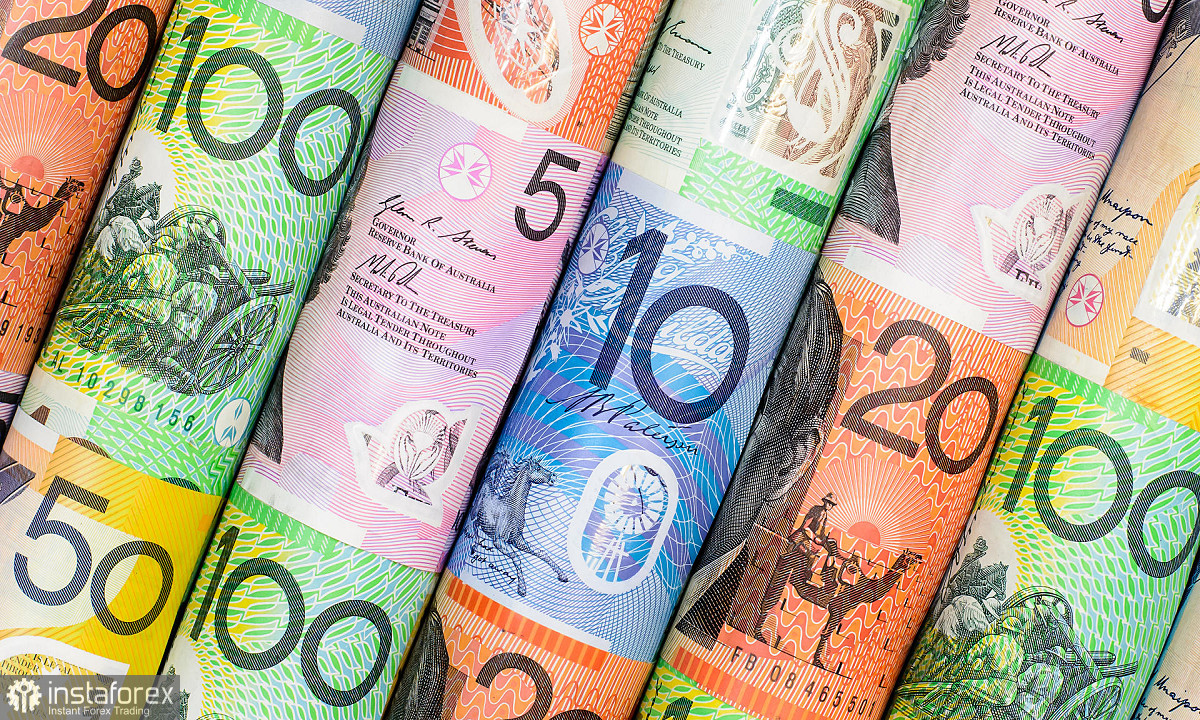The AUD/USD currency pair at the start of a new trading week showed corrective growth, which was due not only to the weakening of the greenback but also to the strengthening of the Aussie. The fundamental picture of AUD/USD oddly formed in favor of the Aussie, allowing buyers of the pair to return to the area of the 63rd figure. Looking ahead, it is necessary to warn that it is impossible to talk about a reversal of the downward trend since, in general, currencies are still in unequal conditions. But at the same time, buyers may well develop a corrective upward impulse, at least to the level of 0.6360 (the Tenkan-sen line on the daily chart). The correction ceiling is the target 0.6420 (the middle line of the Bollinger Bands indicator on the same timeframe).
The Aussie's corrective pullback is due to two general reasons: traders' renewed appetite for risk and hawkish signals from the RBA. The Australian currency received some support amid a decline in the US dollar index.

Demand for risky assets increased yesterday after British Prime Minister Liz Truss canceled key points of the anti-crisis plan, which provided for large-scale tax cuts. The head of government stated that her priority is "ensuring the economic stability of the country," so she decided to cancel the easing of the tax burden announced in September. Moreover, Truss reported that the government will still raise corporate tax in April next year – from 19 to 25%. It is noteworthy that during the election campaign she promised not to do this.
And although clouds are still gathering over Liz Truss (some of her party members have organized a whole campaign against her), the "tax reversal" has reduced the anti-risk mood in the markets by 180 degrees. Interest in risk has also increased amid the publication of quarterly reports by Bank of America and Bank of New York Mellon, which exceeded market expectations. Key US stock indices showed growth, while the safe greenback was under pressure.
The Australian dollar, in turn, received support from the RBA. Recall that at the last meeting, the Reserve Bank of Australia raised the interest rate by only 25 points, although most experts predicted a 50-point increase. The regulator has maintained a hawkish course, but at the same time moderated the pace of monetary tightening. The minutes of the October meeting, published today, cemented these theses, providing background support to the Aussie.
On the one hand, the members of the central bank acknowledged that the tightening of monetary policy has hit housing prices and household welfare "and may lead to a decrease in consumption over time." But on the other hand, they stated another sad fact, which is that inflation in Australia is too high, and could rise to 7.8% by the end of the year, "with rent and utilities increasing pressure on costs."
After weighing all the "pros" and "cons," the members of the Australian regulator concluded that the current situation "requires a further increase in interest rates in the coming period." This suggests that the regulator will tighten monetary policy at a moderate pace in the coming months. This thesis was also voiced yesterday by RBA Deputy Governor Michelle Bullock. She noted, in particular, that the Reserve Bank can achieve the same rate increase as other central banks of the leading countries of the world, while applying more "meek steps".
Australian Prime Minister Anthony Albanese also provided some support to the Australian dollar. Today, he made a statement that his country should cooperate with China "wherever possible." China is Australia's largest trading partner, but in 2020, extremely complex and tense political relations have developed between the countries, so Albanese's "peace-loving" statement played a role.
And yet, longs for the AUD/USD pair look risky. The expansion of the divergence of the monetary policy rates of the two regulators – the Fed and the RBA – will serve as a heavy anchor for the Aussie in the medium term (and even more so in the long term). There is no doubt that the Fed will react to the latest inflation reports in the US by tightening its rhetoric. The market does not doubt that the rate will be increased by 75 points in November. At the same time, confidence is growing that the regulator will also implement the 75-point scenario in December. Therefore, it is advisable to use the current corrective pullback of AUD/USD to open short positions.
This is also indicated by the technical picture. The pair on the daily chart is between the middle and lower lines of the Bollinger Bands indicator, as well as under all the lines of the Ichimoku indicator (including the Kumo cloud). The main target of the downward movement is the lower line of the Bollinger Bands indicator, which corresponds to 0.6180.





















